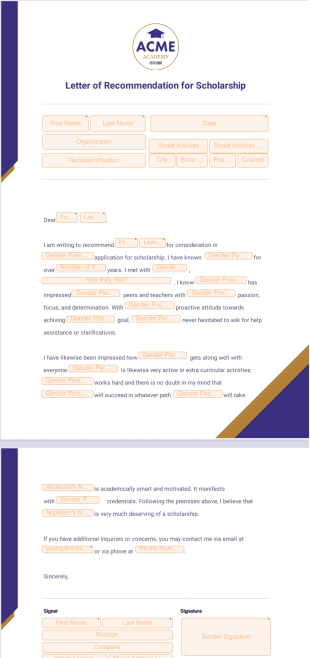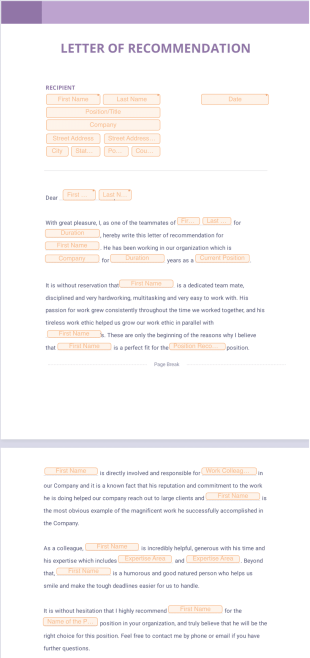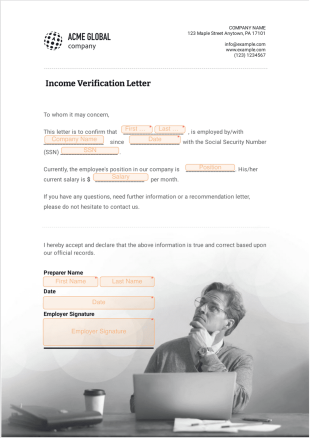Sponsorship Letter
A sponsorship letter is a letter that proposes a partnership between an organization and a sponsor for the organization — whether that be for a specific event, or the organization as a whole. If you need to write a sponsorship letter, do it fast with this ready-made Sponsorship Letter. Jotform Sign lets you fill out, e-sign, and share the letter on any device.
Customize this letter to match your organization by adding your logo, including more e-signature fields for more members of your team, and personalizing other design changes like text font and color. To save time with automation, add a custom signing order to your Sponsorship Letter to forward it to multiple signers automatically.
Sponsorship Letter FAQs
1) What is a sponsorship letter?
A sponsorship letter is a letter requesting funding for an organization. Nonprofit organizations typically write these letters to request funding for an event, a project, or long-term support.
Your organization can use a sponsorship letter to convince an organization or donor to be an official sponsor of a proposed campaign or event. These letters highlight a need your organization has, explain why your organization is worthy of sponsorship, and outline how your request fits with the sponsor’s mission and values. A sponsorship could consist of providing monetary or in-kind donations, mentorship, or other resources.
2) How should you send a sponsorship letter?
While there’s no one right way to send a sponsorship letter, there are a few key guidelines you should consider before sending one:
- Send sponsorship letters to organizations with an existing connection to your organization. Sponsoring organizations receive a number of requests. Without an existing connection, they have little reason to open your letter.
- Give sponsors plenty of time to respond. You’re asking for help, so don’t put the pressure on them to fit your tight timeline.
- Identify the decision-maker. Send your letter to them directly, and include all the required information. If recipients have to follow up and ask questions, they’ll be less likely to commit to a partnership. Sending your sponsorship letter to a general email address or mailroom will likely result in your request ending up lost or rejected.
Keep these tips in mind to increase your chances of getting a response — and potentially a sponsorship.
3) How can I write and design a sponsorship letter?
You can create your letter from scratch as a simple document. But to get a head start, you can use a tool like Jotform Sign that offers sponsorship letter templates, complete with fields for collecting signatures.
Using a template allows you to skip typing out all the basic information and gives you more time to focus on your proposal’s specifics. Templates offer a prebuilt structure and design, and you can then customize them to fit your exact needs, saving you the time and effort of writing and designing your own letter from scratch.
4) How do you determine goals for a sponsorship letter?
Your sponsorship letter should clearly define your goals and objectives for the partnership. Taking the time to build a strong strategy for achieving your goals will set your letter apart. Do the following to create a strong foundation for your letter:
- Identify a need that requires funding or support.
- Research sponsors.
- Match a sponsor’s resources with a plan that resolves your identified need.
- Outline your plan and tie your goals to the sponsor’s mission, practices, and values.
Researching and including this information helps establish your credibility and builds a stronger argument that will increase your chances of obtaining sponsorship.
5) What should you include in a sponsorship letter?
While your sponsorship letter will be unique to your organization’s specific needs, most sponsorship letters include a number of key points:
- Introduction: Define who you are and what you do. You should personalize this section for each recipient.
- Project or event plan
- Reason for the sponsorship request
- Explanation of how you’ll use the sponsorship
- Overview of who the sponsorship will benefit
- Notice of follow-up: Stating that you’ll follow up with a sponsor shows your commitment and clarifies the next step.
- Conclusion and signature
Be sure to build your sponsorship letter to fit your requirements, but don’t forget to include key information that may make the difference between a sponsorship and a rejection.
6) Types of sponsorship letters
Although there are a number of different kinds of sponsorship letters, most fall into two main categories of sponsorship opportunities:
- Event sponsorship: This kind of sponsorship involves asking organizations to provide financial or logistical support for an important event that will benefit a particular audience. This includes silent auction donations, support for specific event expenses, and more.
- General sponsorship: This type of sponsorship covers broader organizational needs, by providing volunteers, recurring donations, or even supply and equipment donations.
Depending on which type of sponsorship you’re seeking, you can use specific letters for
- Event sponsorship
- Educational sponsorship
- Church sponsorship
- Team sponsorship
- Donation requests
Any of these sponsorship types will require a sponsorship letter, so look for available templates, resources, or guidelines to help you streamline the process of creating one.
Letter of Intent for Promotion
Create a letter of intent for promotions at your company. Works on any device — iOS or Android. Drag and drop to personalize. Converts to a PDF automatically.
Professional Letter of Recommendation
Create a professional letter of recommendation in seconds. Works great on any device. Android and iOS compatible. Easy to customize and share. No coding required.
Letter of Recommendation for Scholarship
Create a letter of recommendation for any scholarship application. Drag and drop to design. E-sign in seconds. Works on smartphones, tablets, and desktops.
Letter of Recommendation Template for Coworker
Create and collect letters of recommendations for your coworkers. Drag and drop to customize. Works on mobile, tablet, and desktop devices. No coding.
Income Verification Letter Template
Create an income verification letter that works for your business. Easily customizable. Works on all devices — iOS and Android. Download immediately as a PDF.
Letter of Recommendation for Student
Create and collect letters of recommendations for students with Jotform Sign. Drag and drop to customize. Works on mobile, tablet, and desktop devices.
These templates are suggested forms only. If you're using a form as a contract, or to gather personal (or personal health) info, or for some other purpose with legal implications, we recommend that you do your homework to ensure you are complying with applicable laws and that you consult an attorney before relying on any particular form.






